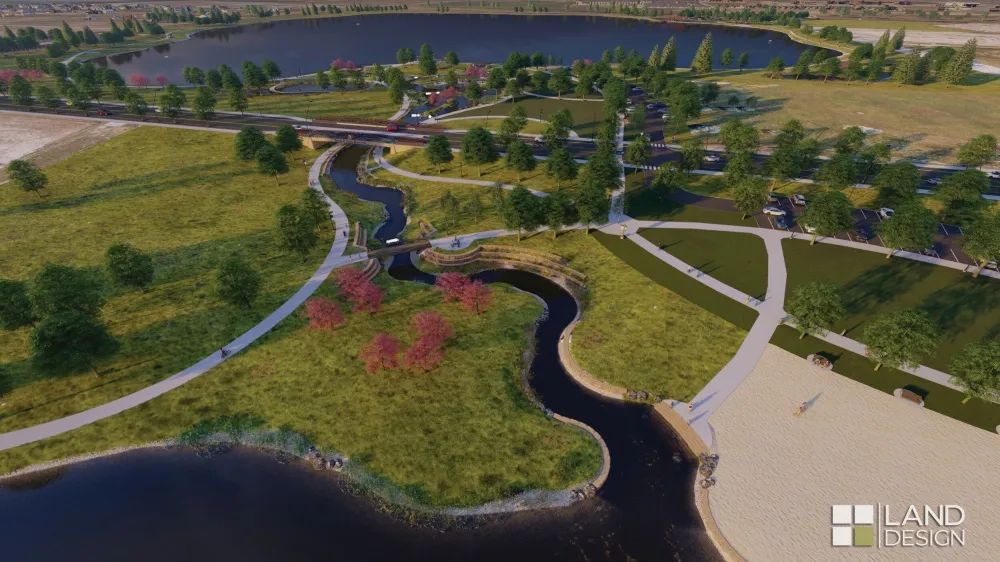
Billings West End Reservoir rendering
Billings Water: A Look at Water Conservation & Sustainability for Today & Beyond
June 2022
by anna rogers | Renderings courtesy of Land Design Inc.
Grounded in a deep understanding of Billings’ water history, decision-makers can better determine the best way forward in providing water to our city. They are continually asking and answering - How can we create systems that will continue to thrive, with benefits instead of detriment to those down the road? A dry climate, unique water situation, large population, portion of the city at a higher elevation, and complete reliance on a wild, undammed river create the need for a water plan that is solid, strong, and sustainable.
Call in the Reinforcements
We know that Billings’ water is all about the Yellowstone River. Our reliance on the river’s water levels puts Billings in a vulnerable position. The city has about eight to ten hours of potable water storage in the summer months.
If an oil pipeline breaks upstream, the city must shut down water operations to let the oil go by. If a drought has river levels low and causes residents to use excess water, existing reservoirs sit at dangerously low levels. If there’s an ice jam in the river, the city is impacted. An eight-to-ten-hour back-up plan is not sustainable, especially with Billings’ rapid growth.
The Billings West End Reservoir is an answer to these unique problems. It includes a second water treatment plant with two reservoirs that will store weeks to months of potable water, creating redundancy and reducing vulnerability from ice jams, low rain levels, and potential oil pipeline issues.
The West End Reservoir project utilizes current water rights and creates a plan to sustain about 360,000 people. Combined, the north and south reservoirs will cover 160 acres – about three times the size of Lake Elmo. The reservoirs will be located on Hesper Road between Shiloh and 48th Street, occupying what was a Knife River gravel pit site.
In addition to water storage and treatment, the reservoir project improves the quality of life for Billings residents – forming a new, beautiful area for people to swim, fish, walk, bike, and picnic.
Power & Money – Lots of It
Where does most of the energy used in our city go? It is used to treat water. The best way to use less energy in Billings is strongly connected to our water usage. Conserve water, and conserve energy.
“The biggest thing residents can do to conserve water is create water-efficient landscapes,” says Louis Engels, Water Quality Superintendent for the City of Billings. Using less water in yards will have the greatest impact on our collective water usage. Water reuse and raw water (ditch) irrigation are encouraged for homes adjacent to ditches.
In addition to the power required to treat water, Billings spends a good deal of money moving water. The West End Water Treatment Plant will intake water 90 feet higher than the current intake – saving roughly $250,000 in power costs connected to moving water per year.
The city is looking into options to offset the energy and costs associated with treating and moving water. Engels explains, “We plan to put a solar array over the wastewater treatment plant. One potential issue with this is the hydrogen sulfate gas that comes off the wastewater. It can eat up electrical equipment - so is the best place for that microgrid at the wastewater plant? Would we lose the longevity and consistency of the panels? There are other cities that are doing this.”
There is also potential to get hydropower, but Billings doesn’t have a huge elevation drop that would allow us to capitalize on hydropower.
Strong Returns
Billings relies on the Yellowstone River, and returning water to the source is part of the city’s Integrated Water Plan. The current water reclamation facility provides water back to the Yellowstone year-round, ensuring the reclaimed water quality meets standards.
The city is also recovering phosphorous from the wastewater plant as an amendment to landfill compost. The goal is to partner with other public waste management operations to create a closed-loop in the phosphorous cycle. Since phosphate is a non-renewable resource and global supply is dwindling, recycling phosphorous from wastewater biosolids provides an alternative source for this crucial element in agricultural fertilizer.
Collecting and utilizing stormwater is another piece of the water management puzzle. Stormwater requires treatment but may be a source of water supply for appropriate uses.
Looking Forward
Water in Billings is as it always was – reliant on the river – but also constantly evolving with new plans and projects to better utilize, conserve, and supply water to the Billings area.
The guiding principles of Resiliency and Redundancy, Smart Growth, Quality of Life, and Sustainability will bring quality, reliable water to people in the Yellowstone valley for generations to come.
Originally printed in the June 2022 issue of Simply Local Magazine
Never miss an issue, check out SLM's digital editions here!





